Your faucet uses a system of valves and handles to control the temperature and flow of water in your bathtub or shower. In many cases, faucet problems stem from one of these components. Replacing or repairing a faucet isn’t difficult, but the process will vary based on your plumbing and the nature of the issue. Here’s a look at a variety of solutions for your troublesome faucet or valve.
On This Page:
- Steps to Replace/ Install Faucet by Type
- Additional Considerations
- Repairing a Leak
- Installation by Brand
- Is It Time To Upgrade?
- Hiring a Pro
How to Replace or Install Valves by Faucet Type
Important note: Be sure to turn off the water before you begin. If you can’t find the valve that turns off the shower, turn off the water to the entire house (should be in basement or outside). Then turn on the shower and let the pipes drain out. When you turn the water back on, turn on all of your taps to force out any air that may have gotten in. When the water flow is steady, you’re done.
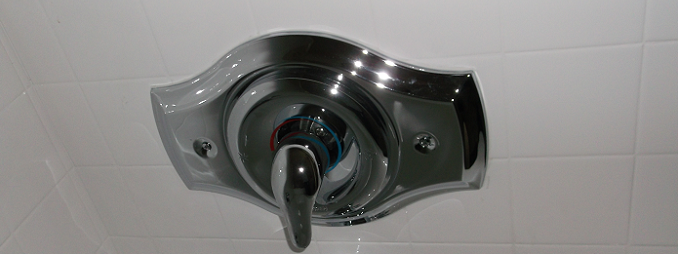
Single-Handle Faucets
Commonly found in single-handle faucets, valve cartridges are cylindrical devices that use O-rings to control the flow of water. Replacement is the easiest way to fix cartridge-related problems.
- Time: 15 minutes to 1 hour
- Cost: $20 to $100
- Tools:
- Phillips screwdriver
- Small flathead screwdriver
- Pocketknife
- Optional- Handle puller and/or cartridge puller (may require an adjustable wrench)
- Turn off your water.
- Locate the set screw under the handle or cap at the front of the unit. Remove the screw and pull.
- Use a screwdriver to remove the retainer clip at the top of the cartridge housing. Be sure not to lose this piece.
- Remove the cartridge by gently pulling with pliers. Some manufacturers provide a cap that threads onto the valve to aid in removal. You may have to buy a cartridge removal tool if it’s stuck.
- Take the old cartridge to the hardware store to ensure you get the right replacement. Cartridges are specific to faucet make a model.
- Insert the new cartridge.
- Replace the retaining clip and reassemble your faucet. Turn the water back on to make sure your faucet doesn’t leak.
Note: Replacing your cartridge’s O-rings can sometimes help. O-ring kits cost around $1.00.
Ready to start your shower faucet?
Find Pros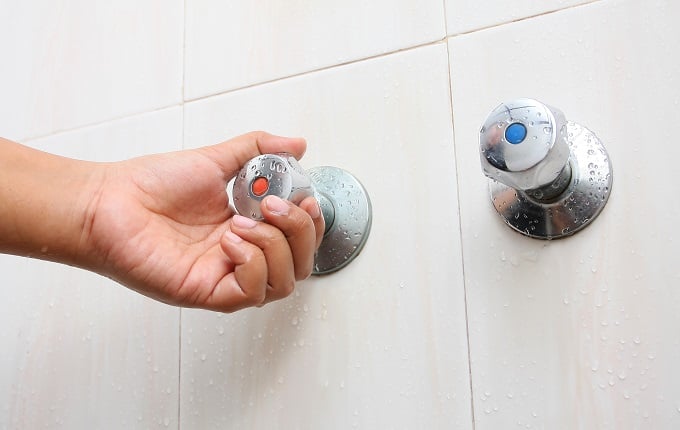
Two-Handle Faucets
Common in two-handle faucets, stems are mechanisms that use threaded handles and rubber seals to open and close water lines. Installing a new stem is the easiest way to fix a malfunction, but you can an also replace faulty hardware like seals and O-rings.
- Time: 20 minutes to 1 hour depending on experience
- Cost: $1.00 to $3.00 depending on faucet manufacturer
- Tools:
- Phillips screwdriver
- Small flathead screwdriver
- Pocketknife
- Pipe wrench
- Optional- Handle puller and/or shower valve socket wrench
- Pry away the index cap at the front of the handle to access the handle screw. Remove the screw and pull. Use a handle puller if it’s stuck. You can buy a puller at your local hardware store for between $9 and $15.
- Use pliers to gently turn the stem counterclockwise.
- Remove the screw at the end of the stem and install a new washer. Be sure the replacement washer is an exact match and coated with petroleum jelly.
- Find the O-ring and swap it out with a new one as well. Be sure to coat the new O-ring in petroleum jelly.
- Screw in your new stem and add the handle hardware back in place.
- If you’re installing a new stem, throw the old one away and screw in your replacement.
- Put the bonnet nut and handles back on the unit.
Ready to start your shower faucet?
Find Pros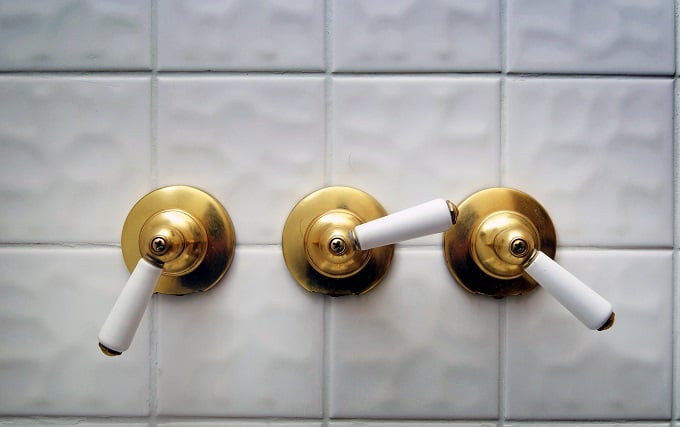
Three-Handle and Diverter Faucets
Three-handle faucets have temperature stems (hot and cold handles) and diverter stems. Here’s how to repair both:
- Time: 15 minutes to 1 hour depending on experience
- Cost: $3.00 to $27.00 depending on manufacturer of replacement parts
- Tools:
- Phillips screwdriver
- Small flathead screwdriver
- Pocketknife
- Pipe wrench
- Optional- Handle puller and/or shower valve socket wrench
Temperature Stems
You can fix temperature stem issues the same way you would a two-handle faucet. Here’s a quick how-to:
- Pry away the index cap at the front of the handle to access the handle screw. Remove the screw and pull. Use a handle puller if it’s stuck. You can buy a puller at your local hardware store for between $9 and $15.
- Use pliers or a deep-socket wrench to gently turn the stem counterclockwise.
- Wrap Teflon tape around the base of your stem and screw it into place.
- Replace the handle hardware.
Wall Diverter Stems
Your wall diverter is usually the third handle in a three-handle valve. Swapping out your faulty diverter valve is the easiest way to address this issue. Here’s how:
- Remove the cap and handle as in the single handle guide. You may have a sleeve over yours. Gently remove it, being careful not to mar the finish.
- With a socket wrench, remove the old valve.
- Wrap Teflon tape around the threads of the new valve, leaving the first few threads bare to ensure a grip.
- Insert the new diverter and give it an extra quarter turn after it’s tight. Do not force it.
- With the handle, turn it and test the water to make sure it only comes out of where it’s supposed to. This is also a good time to shine a flashlight into the valve and make sure there are no leaks.
- Reassemble the diverter handle.
Ready to start your shower faucet?
Find ProsBall and Thermostatic Faucets
Ball and thermostatic valves will require the help of a professional. These faucet designs utilize complicated designs that aren’t as DIY-able as stems or cartridges.
Additional Replacement Considerations
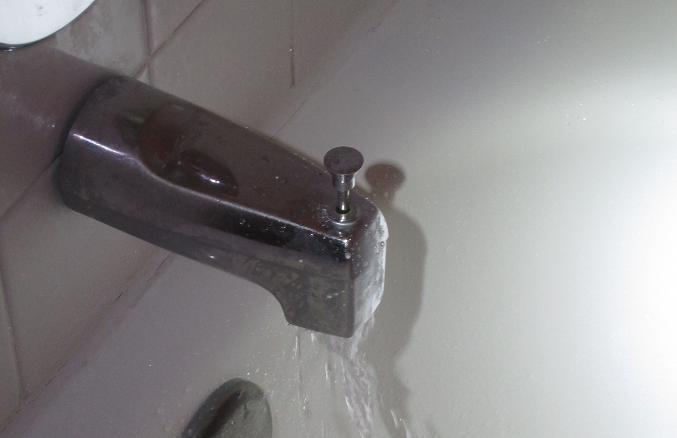
Tub Spout Diverter
A faulty diverter in your spout will affect the efficiency of your shower. Replacing your tub’s spout is the easiest way to solve this problem. Here’s a how-to:
- Time: 15 minutes to 1 hour
- Cost: $3.00 to $27.00
- Tools:
- Phillips screwdriver
- Small flathead screwdriver
- Pocketknife
- Flashlight
- Channel locks
- Shower socket wrench (for wall-type)
- Teflon tape
- Plumber’s dope
- Optional– Handle puller
- Using channel locks or a pipe wrench, turn counterclockwise to remove the tub spout. The old pipe should come off as well. If not, use the wrench to remove it. Some spouts are held on with a set screw. Check for this before trying to turn the spout.
- Clean the wall to ensure a snug fit.
- Your new spout should come with a new pipe. Wrap both ends in plumber’s tape to ensure a good seal.
- Screw in your new pipe and tighten it with a wrench.
- Screw on the new tub spout and tighten it with a wrench. Wrap cloth or something protective around the spout to avoid marring the finish. If it has a set-screw type, just slide it on and tighten.
- Apply a bead of caulk where the spout meets the wall.
Repairing a Leaky Faucet
It’s normal for your shower to drip for a few minutes after the water is turned off. But a steady flow may indicate a leak. Replacing your faulty hardware is a common fix, but leaks can also be stopped by repairing your valve or stem. Here’s a quick rundown of simple repairs.
The majority of problems stem from a faulty valve or component. Bad O-rings and faulty seats and seals are repairable issues. In most cases, replacing the damaged hardware is the best way to improve the issue, but gently soaking and scrubbing cartridges or stems can remove buildup and improve its sealing capabilities.
Repairing or replacing your faucet components isn’t always easy. Call a pro if you’re unsure about tackling either of these jobs.
Faucet Installation by Brand
Most faucet hardware installations are simple. But some can vary based on their brand. Here’s a quick guide for the three major faucet manufacturers.
Kohler
- Install the spout. You can screw on your spout if the water pipe has a threaded end. Be sure to remove the slip-fit assembly before you begin. If the end is smooth, use sand paper to rough the end of the pipe and then slide on the spout. Tighten the set screw.
- Apply sealant. Apply sealant around the base of the spout. Wipe away any excess using a clean rag.
- Reassemble the faceplate. Connect your retainer and seal plate. Place sealant on the back of the seal plate and press it against the wall. Tighten any screws to ensure a water-tight connection. Place the faceplate over the retainer.
- Add the handle. Place the handle over the valve and secure it. How you secure your handle will vary based on its design.
- Install the showerhead. Place sealant tape around the end of the pipe and screw on the head.
Moen
- Install the stop-tube. Slide the stop tube over the cartridge.
- Replace the trim plate. Place caulking around the outside edge of the trim plate and press it against the wall. Be sure to attach the eschaton screws as well. Slide the key- and temperature-stops in place.
- Screw in the level-handle adapter.
- Attach the handle Place the handle on the adapter and tighten the hex or set screw.
- Add the spout. Add thread tape to the end of the pipe. Apply caulk to the base of the spout and screw it in place.
- Final Touches. Add thread tape to the end of the showerhead pipe and screw the head into place.
Delta
- Install the spout. Add thread tape to the end of the pipe. Apply caulk to the base of the spout and screw it in place.
- Add the O-ring. Slide the O-ring over the faucet.
- Slide in the eschaton Slide it over the cartridge.
- Replace the trim plate. Place caulking around the outside edge of the eschaton and press it against the wall. Add the screws and tighten them.
- Attach the handle. Place the handle on the adapter and tighten the hex or set screw.
- Final Touches. Add thread tape to the end of the pipe and screw the head into place.
Ready to start your shower faucet?
Find Pros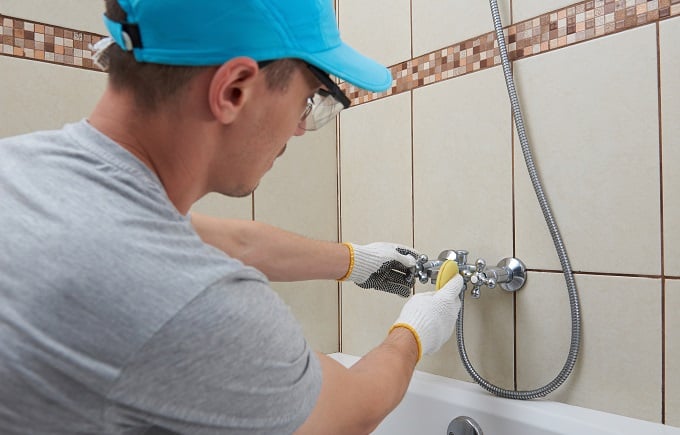
Is It Time to Upgrade?
Knowing when to upgrade your faucets isn’t always easy. Fortunately, there are several clear signs it’s time for an update. Here are a few indicators your faucets need an upgrade.
Mineral Buildup
Hard water will leave behind a residue that can affect the looks and usability of your fixtures. Over time, this mineral buildup will accumulate in your valves and showerhead and make replacement a must. Ignoring mineral residue will impact your water flow and turn a relaxing shower into a frustrating chore.
Aesthetics
Sometimes a simple faucet and handle upgrade is all that’s needed to give your bathroom a quick facelift. You might be doing this for a sale, or you may just be tired of looking at the same style. Regardless, the outdated hardwear can ruin the charm of your bathroom — even after a total remodel.
If you’re repairing or replacing a valve or cartridge, go ahead and treat your shower to a whole new look!
When to Call a Pro
Don’t hesitate to call a pro if you’re unsure about any part of your faucet repair or installation. DIY mistakes can lead to serious problems like leaks and flooding. Additionally, mishaps can reduce the energy efficiency of your home, resulting in increased utility bills.
Check out our Faucet Installation Cost Guide to learn how much it will cost to hire a professional for this project.

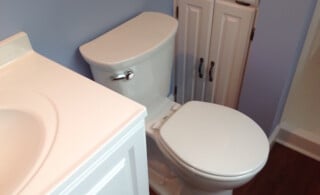 Toilet Installation – Learn to DIY or Hire a Pro
Toilet Installation – Learn to DIY or Hire a Pro  How to Install or Replace a New Shower Head
How to Install or Replace a New Shower Head 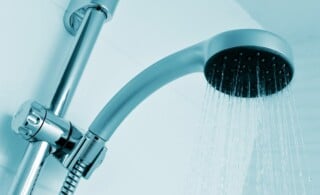 How to Install a Removable, Handheld Shower Head
How to Install a Removable, Handheld Shower Head 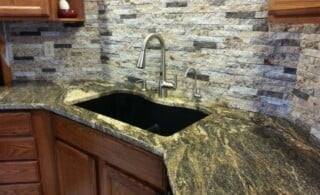 Corner Bathroom and Kitchen Sinks
Corner Bathroom and Kitchen Sinks 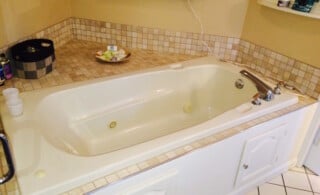 What to do with an Old Bathtub
What to do with an Old Bathtub 

I have an old three valve system when the plastic handle is removed there is a cupped flange attached to the valve stem. This device limits the removal of the bulkhead flange and access to the valve how dose this device attach to the stem? I have tried to remove by twisting both directions . I have not tried a puller. Any suggest
how do I found out the brand name of my current shower faucet and valve . The only thing my faucet know says is peerless. When we try to adjust the water temperature it might be to cold, then it gets to hot. what do I need to get to fix it.
I have replaced the seat and valve stem on my tub with new. when I turn on the water it leaks out of the back of my handles. why is this happening
I replace delta cartridge and shower head but it still has a constant drip. What do I do?
Thank you! My faucet was turning all the way around both directions. All it was, was the silver thing that the valve sits in was loose and needed to be tightened . I guess its called the stop tube….. I have been dealing with trying to find the place my faucet turns off and whistling for 4 months !
I’m trying to repair my shower diverter. There is no seat washer. Is this normal?
Purchased single anti-scald single handle faucet by Moen approximately 2 yrs ago. It is now changing water temp by itself and the pressure has greatly decreased
I went to change a simple cartridge from my delta shower. watched the delta video. Did great until the pulling out of the cartridge was pretty stiff I used vice grips ever so easily and the front part of the cartridge did come off exposing the two tips with washers on it so I latched on to those and carefully tried moving that but the hard water has made that brittle and both snapped off. so I tried needle nose and it wont budge. exposed is two small holes so I tried screwing a screw in that so I would have something to grab on to no luck. Suggestions please
Which direction does the flat spot go on a 3 handle shower diverter stem by Delta
I’m trying to repair my shower diverter. There is no seat washer. Is this normal? and how is a diverter defective. Mine looks okay but the water still flows between the shower and the faucet, why?